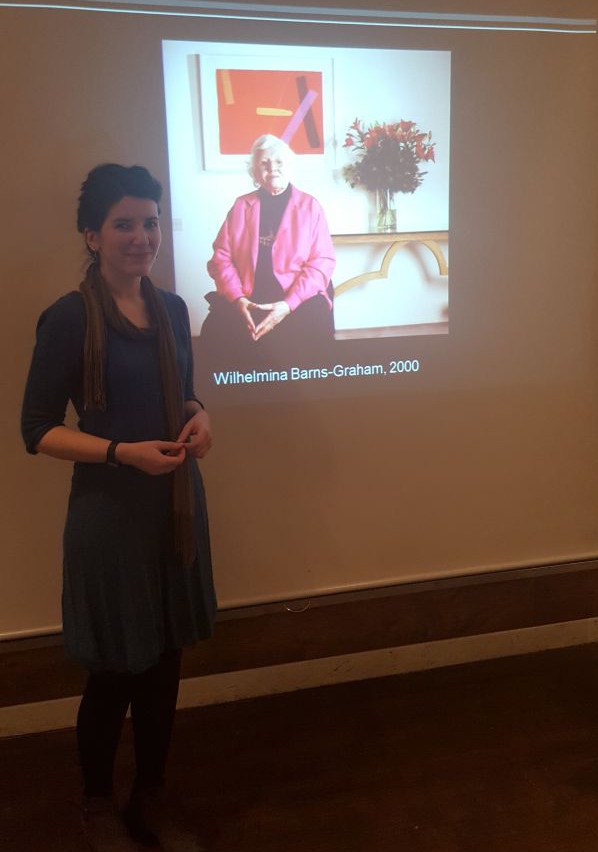Bronchial but always energetic, Scots artist Wilhelmina Barns-Graham (1912-2004) divided her working life between Fife and Cornwall, and has left a body of work across the UK and internationally. Early days were spent in St Andrews, but in 1924 she moved to the family estate at Carbeth in Stirlingshire. Her father was unhappy that her health might not be strong enough for her to go to art college, but help from her aunt enabled her to go to the Edinburgh College of Art, where her teachers included Gillies, Maxwell, MacTaggart and Peploe. Encouraged to study the natural world, she showed skill in capturing form in a process of distillation, and her love of colour was heightened by a condition known as colour synesthesia, which prompted automatic associations between numbers, places, memories or people and specific shades of colour. She blossomed in the company of fellow artists like William Gear and Margaret Mellis, graduating in 1937, but the political shadows over Europe counted against travel to say France or Germany, so the Principal suggested St Ives where she arrived in March 1940.
A studio over Porthmeor Beach was to be her first base, and she was inspired by fisherman turned artist Alfred Wallis. In 1943 she joined the St Ives Society of Artists which brought together the academic and the avant garde, and subsequently she became a member of the Crypt Group, which was made up of artists who worked exclusively in a modern abstract style. She later became a founding member of the progressive Penwith Society of Arts in 1949. Climbing in Switzerland inspired an interest in light, shapes and stones, and she set about capturing these ideas in a glacial abstract theme seen in her Upper Glacier sketch purchased by the British Council in 1950. Pencil studies of that decade depicted the reduction of landscape features to their elements, and an Italian Government Scholarship in 1954 allowed her to travel around Italy. Offset printmaking proved an ideal technique for her glacier studies, and at the Penzance School of Art she mastered skills in etching, engraving and linocut. Aware of European developments from her travels in the 1950s with her husband David Lewis, she began teaching at the Leeds College of Art during his study of architecture in that city, and this period while one of isolation in personal life was marked by production of powerful paintings with a mathematical quality founded on the golden section principle.

Helen Scott
Disintegration of her marriage led her to return to St Ives where she redoubled her efforts, but in 1960 her aunt Mary Neish left her Balmungo House in Fife, and acquisition of the No 1 Barnaloft studio at St Ives in 1963 provided the second of the bases between which her life would now be split. Balmungo inspired oil on canvas and oil on board works using colour in line with the pop-art movement and in 1968 she exhibited at the de Marco Gallery, but in the 1970s she returned to nature as the source of her inspiration in line drawings and ink studies, having the proximity of the sea at both locations to inform her investigations which embraced waves, ice and soil. Her prolific output between 1975 and 1983 was helped by the friendship of Rowan James whom she had met at St Ives in 1973, and as her health deteriorated Rowan took on the roles of caretaker and gardener, cook and business manager, freeing “Willie” up to concentrate on her art. In 1980 her series of expanding forms inspired by the wind blowing across sands used less confrontational colours, and a visit to Orkney inspired her to build up a series of collages based on Orcadian landscape features. In the 1980s she reverted to landscape depicting shifting light. Working in parallel on different techniques was a feature of her career which fell between the generations of Ben Nicholson and Barbara Hepworth and later Peter Lanyon and Patrick Heron. Compared to these earlier and later artists her reputation was somewhat marginalised during the 1960s, 70s and 80s, and at times she felt crowded out by the hothouse atmosphere of St Ives. Only three of her paintings were included in the Tate exhibition ‘St Ives 1939-64: Twenty Five Years of Painting, Sculpture and Pottery’.
In 1989 a touring retrospective exhibition of her work was staged at the City Art Centre in Edinburgh, and in the 1990s she achieved real commercial success. However, she did not rest on her laurels, between bouts of illness capturing the landscapes of Lanzarote and the Olympic cityscape of Barcelona. Her methods now ranged from paint-flicking to calligraphy, with the Scorpio series in bright colours and she worked on silkscreen printmaking with Graal Press, mixing up to fifteen colours to achieve one tone. Receiving the CBE in March 2001, she collected honorary degrees from four Universities, became an honorary member of the Royal Scottish Academy and had a solo Tate exhibition at St Ives. Declaring “at my age there is no time to be lost”, she continued painting until 2003, trying to capture the one simple statement about life and nature that was always her goal. From her death in January 2004, the Barns-Graham Charitable Trust that she had founded in 1987 has worked to foster and protect her reputation by making her works accessible to researchers and the public through exhibitions and on line. Her centenary was marked by exhibitions at Perth, Dumfries, St Ives and London as well as at Edinburgh’s City Art Centre, and Balmungo House was opened to the public, but the Trust’s main purpose was to award travelling scholarships of the sort that had helped launch her career and in 2014 it was decided to sell the House so as to support this programme of up to sixteen bursaries annually.